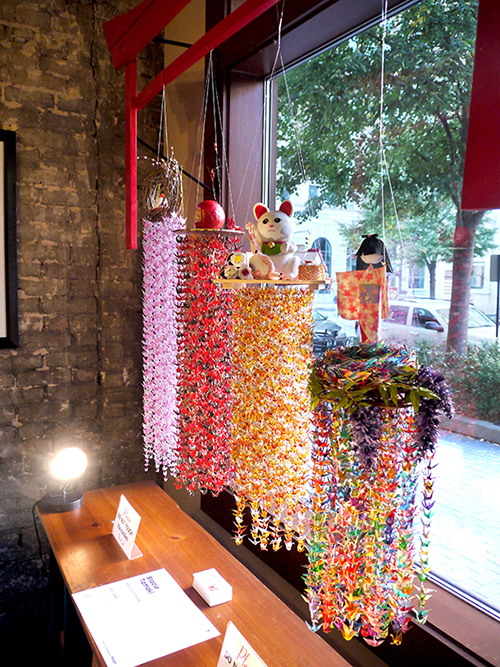I spent the better part of yesterday in Grand Rapids and the better part of this year working on my latest entry for ArtPrize 2015. You can view my ArtPrize profile at this link.
You may recall that I entered the same competition in 2014. I’ve found it’s the one thing that has motivated me to not only begin producing art but to focus on becoming a full-time working artist able to support myself by earning a living wage.
Last year many ArtPrize visitors encouraged me to make larger cranes if I want to be a serious contender to win the $200,000 cash Grand Prize by receiving the most public votes (large scale works have historically been more successful at this particular competition), but tiny is my thing so I’m sticking with it. Call me a rebel 🙂
This year my entry is titled “4000 Culture Cranes.” I created 4 mobiles ranging in size from 1/4″ to 3/4″ high. The finished mobiles range from 7″-8″ in diameter and from 24″-36″ in length. Three are comprised of 1000 cranes each while one set (Sadako) ended up with 2000 cranes. LOL Last year the first thing people asked was “How many are there?” so I incorporated the number 4000 into the title. Then, 48 hours before the opening day I decided to deconstruct a set of cranes I’d made years ago and incorporate them into this year’s entry increasing the total but too late to change the title of the piece to 5000 Culture Cranes.
The series is hanging in the front window at the Grand Central Market and Deli.
It’s located at 57 Monroe Center NW right in the heart of Downtown Grand Rapids and less than a block and a half past the Grand Rapids Art Museum (aka The GRAM) heading east down Monroe Center NW.
Each mobile is themed after a different Japanese cultural tradition. Two are more readily recognizable and two are less well known. From left to right they are:
- Sadako and the 1000 Paper Cranes: World peace
- Maneki-neko: Prosperity and good luck cat
- Daruma: Goal setting (aka Wish Doll)
- Mochibana and Kagami Mochi: New Year decorations both made from the sweet confection mochi
I’ve created brief photo journals of the build process for each mobile. To challenge myself I decided to try working with air dry clay for the first time. For the larger pieces like the Maneki-cat and the Daruma I used styrofoam to carve base forms then covered them with a thin layer of clay which then had to be painted.
Other elements were made of paper, wire, and beads. Some of the sushi that surrounds the cat are made of origami and other pieces are sculpted/formed with paper but not technically origami. A lot of prototyping and pattern making was involved for both the sushi and the washi paper doll of Sadako.
The Daruma and Maneki-cat also required hand-painting fine detail work to the finished sculptures. I don’think I’ve done that type of painting in well over a decade. Was relieved to know it’s (apparently) like riding a bike.
The 3-D washi paper doll of Sadako was a challenge because I could only find one tutorial online that kind-of showed how it’s done. The designer was generous to share photos of each step but didn’t include size or dimensions of each element so it took a day or two of mocking up the prototype testing each piece over and over until I figured it all out.
Quite a few kids had asked me last year if I was familiar with the story of Sadako and the 1000 Paper Cranes. They had read the book about her so they knew she was a 12 year old girl who suffered radiation poisoning when the atom bomb was dropped on Hiroshima. Several years later she developed cancer and attempted to fold 1000 cranes so the Gods would grant her single wish to be healthy again. The crane is a symbol of longevity in Japan as a legend says the cranes live for 1000 years. Sadly, Sadako passed away before completing her cranes. The school children of Japan took up a collection to raise money to have a sculpture made of her that stands today in Hiroshima’s Peace Park. I wanted to create a mobile that reflected her story, something with resonance to connect visitors to the cranes in a small way.
One of the biggest and kind of funny challenges was for the mochibana mobile. A New Year’s decoration the sweet sticky rice confection known as “mochi” is left in its natural white color and some is dyed pink. Small portions are wrapped around willow branches to represent flower blossoms in the winter when there are none. My dilemma? Where to get willow branches. There are MANY huge weeping willow trees all around Western Michigan, but I felt weird knocking on a stranger’s door and asking for some of the tree in their front yard. For months I drove around with willow-envy and was working up my nerve to ask a stranger for some of theirs when a chance visit solved my problem. It turned out my friends have a gigantic weeping willow on their property! Problem solved. The both the kagami and mochibana mochi are also also made of air dry clay.
I can’t convey how happy I am to be creating again. That pushing my limits, trying new things, being able to attend ArtPrize each day to talk to people about my work, it’s all like that Mastercard commerical: Priceless.
I love ArtPrize so much I’m already planning next year’s entry! If you’ve never been to ArtPrize it’s well worth visiting. It’s a fun, and imaginative art experience where you can wander around 3 square miles of Downtown Grand Rapids and view an incredible array of creativity all in public spaces and venues.














